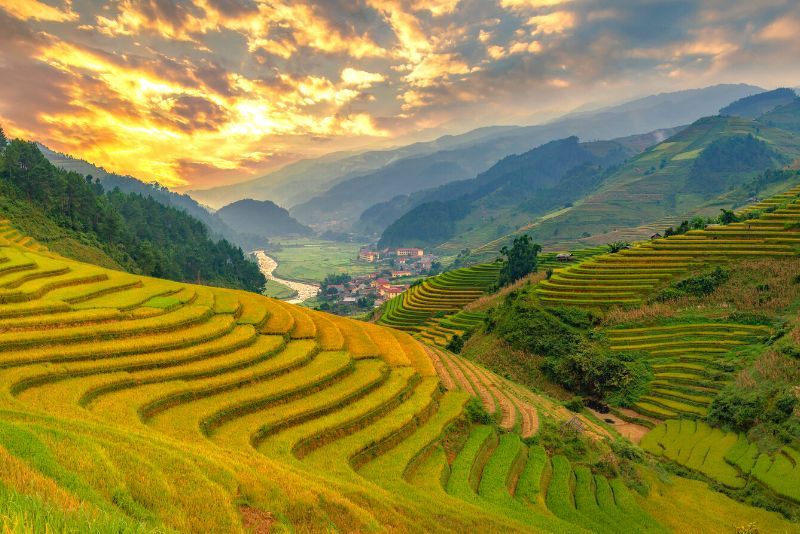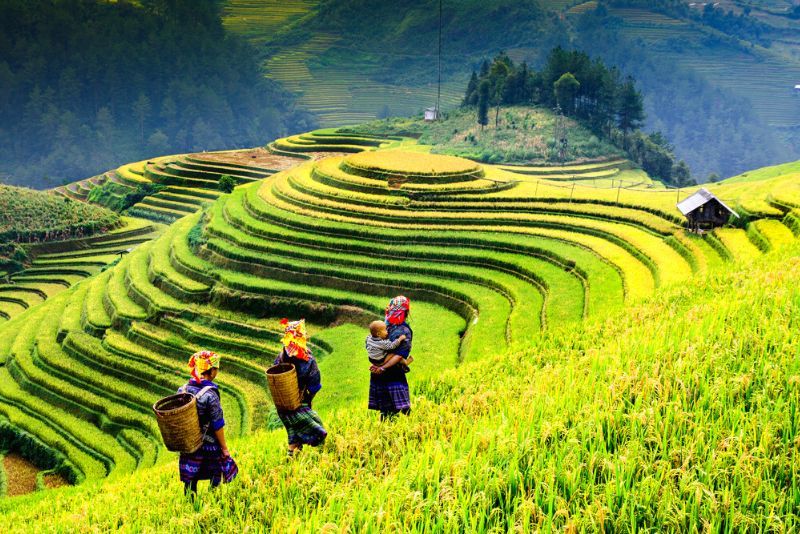Sapa: Day Trips and Tours from Hanoi
Sapa is a region of outstanding natural beauty, hidden away in the Vietnamese mountains. The area is abundant with verdant rice terraces, towering peaks and lush bamboo forests. It is also home to a diverse range of ethnic minority groups, each with its own unique culture and tradition.
A multi-day trip to Sapa from Hanoi is the best way to experience the region's different communities and natural wonders.
Sapa is a region of outstanding natural beauty, hidden away in the Vietnamese mountains. The area is abundant with verdant rice terraces, towering peaks and lush bamboo forests. It is also home to a diverse range of ethnic minority groups, each with its own unique culture and tradition.
A multi-day trip to Sapa from Hanoi is the best way to experience the region's different communities and natural wonders.

(0/24) checking Musement...
Sapa is a region of outstanding natural beauty, hidden away in the Vietnamese mountains. The area is abundant with verdant rice terraces, towering peaks and lush bamboo forests. It is also home to a diverse range of ethnic minority groups, each with its own unique culture and tradition.
A multi-day trip to Sapa from Hanoi is the best way to experience the region's different communities and natural wonders.

You will find below all the information you need to know about Sapa, one of the most popular destinations for day trips from Hanoi.
How to get to Sapa from Hanoi?
Sapa is located in the northwest of Vietnam, close to the Chinese border. The town is approximately 320 kilometers from Hanoi. Because of its distance from the city, the best way to explore the town is on a multi-day trip from Hanoi to Sapa.
From Hanoi to Sapa by car
The journey to Sapa by car is easy. It takes approximately five hours to drive the long distance between the two locations but follows one road — the CT05 — all the way.
From Hanoi to Sapa by bus
Making the jaunt to Sapa from Hanoi is simple by public transport. You can catch a direct bus from Hanoi Hoan Kiem, which departs three times a day and costs around US$15. The journey takes six hours, and if you want to make the most of your time in Sapa, you can opt to travel overnight.
Guided tour to Sapa from Hanoi
Alternatively, you can arrange a guided excursion to Sapa. You'll be picked up from your hotel in Hanoi in the early morning, and tours usually last two or three days.
What is the typical itinerary of a multi-day tour to Sapa from Hanoi?
Many multi-day trips to Sapa make the five-hour journey from Hanoi by a luxury limousine. You may break up the route with a stop at the city of Lao Cai, where you can enjoy a traditional Vietnamese breakfast.
You'll reach Sapa around lunchtime, and after devouring a local meal, you'll set off on your first trek, which takes you to Cat Cat village. Here, you'll meet some of the Black Hmong people, before continuing on to a waterfall at the base of Fansipan Peak.
You'll stay in Sapa overnight, either in a local hotel or in a homestay. On your second day, you'll hike to Ta Van village to see the traditional ways of the Red Dzao people. The hike itself is delightful, and you're bound to fall in love with Sapa as you journey through its ride paddies, and streams.
You'll also have some free time to explore Sapa before boarding your vehicle and making the journey back to Hanoi. If your tour lasts three days, you'll also visit the villages of Y Linh Ho, Giang Ta Chai and Hau Thao village.
What kinds of tours are available to go to Sapa?
There are different options for multi-day tours to Sapa, depending on how long you'd like to visit for and where you'd like to stay.

2-Day trekking tour to Sapa from Hanoi
You'll begin your Sapa two-day trip from Hanoi in style, with a limousine transfer to the town from Hanoi, with a detour at Lao Cai. Once you reach Sapa, you'll trek to see the indigenous Black Hmong people and a waterfall at the bottom of Fansipan Peak.
You'll stay overnight in a charming local hotel and start the following day with a hiking excursion to the villages of Lao Chai, and Ta Van. Before you return to Hanoi, you'll have some free time in Sapa to enjoy the local cuisine, shop for gifts or simply soak in the atmosphere.
2-Day trip to Sapa plus homestay from Hanoi
This two-day Sapa tour follows a similar itinerary to other two-day excursions, however, rather than a hotel, you'll stay in a local family homestay overnight. This provides you with the ideal opportunity to see what traditional life in Vietnam is like.
You'll share meals with your host family, and once you bid them goodbye the following morning, you'll trek to the village of Y Linh Ho.
3-Day tour to Sapa from Hanoi
After following a similar itinerary to other Sapa tours, on this 3-day tour from Hanoi you'll spend your second night in the village of Ta Van, where you'll learn about the Zay people. The following morning, you'll embark on a challenging uphill trek through the rice paddies to the villages of Giang Ta Chai and Hau Thao, before returning to Hanoi.
How much does a tour to Sapa from Hanoi cost?
The most budget-friendly way to enjoy a multi-day trip to Sapa is by spending the night in a local homestay. You can expect to pay between US$70 and US$110.
Multi-day tours to Sapa that include an overnight stay in a hotel and a limousine ride from Hanoi cost between US$110, and $150. If you pay towards the higher end of this range, you'll secure a better hotel.
If you wish to stay in Sapa a little longer, you can arrange a three-day tour, which costs between US$150 and US$180.
What will you see and do on a Sapa multi-day trip from Hanoi?
Sapa
Sapa is a small town in northwest Vietnam. It is located in the Hoang Lien Son mountain range and is known for its stunning scenery, including rice terraces, waterfalls, and mountain vistas.
The town itself is home to a few traditional buildings, as well several shops, where you can buy handicrafts made by the local minority people. There are also many trekking routes in the surrounding area, which allow you to explore the rice terraces, valleys and traditional villages that make Sapa so unique.

Lao Chai village
Just outside of Sapa, Lao Chai village is a quiet oasis amidst the hustle and bustle of daily life. The village is home to the Black Hmong, an ethnic minority group that has lived in the area for centuries.
For the Black Hmong, traditional life revolves around worship and community. The women are known for creating indigo cloth from hemp. Despite the changes that have come from tourism, Lao Chai village remains a close-knit community where everyone knows and cares for one another.
Visitors are always warmly welcomed and quickly become part of the village family.
Ta Van village
Ta Van is home to the Red Dzao, an ethnic group that is believed to have migrated from China in the 12th century. The Red Dzao have managed to maintain their traditional culture despite being surrounded by other ethnic groups.
Ancestry plays an important role in their everyday lives and there is a clear divide between the roles of men, and women. Traditionally, the men build houses and take care of business, while the women create traditional tinctures from herbs, and tend to the rice fields.
The Red Dzao are identifiable by their clothing, which features brightly-colored embroidery, as well as their vibrant red headpieces.
When is the best time to visit Sapa?
There are two ideal times to take a day tour from Hanoi to Sapa — during the spring or fall. From March to May and September to November, the climate is mild and dry, which creates the ideal conditions for trekking.
The harvesting of the rice fields happens during the months of September and October, which is enjoyable to watch.
Travel tips
- Ensure you have plenty of cash on you when participating in a multi-day trip to Sapa. There are cash machines in the middle of town, but none in the surrounding villages.
- Sapa tours involve plenty of trekking. For this reason, you should bring comfortable shoes and clothing.
- If you are able to choose between an overnight stay in a hotel or a homestay, opt for the homestay. You'll meet local people and see the Vietnamese way of life in a way you won't experience otherwise.
